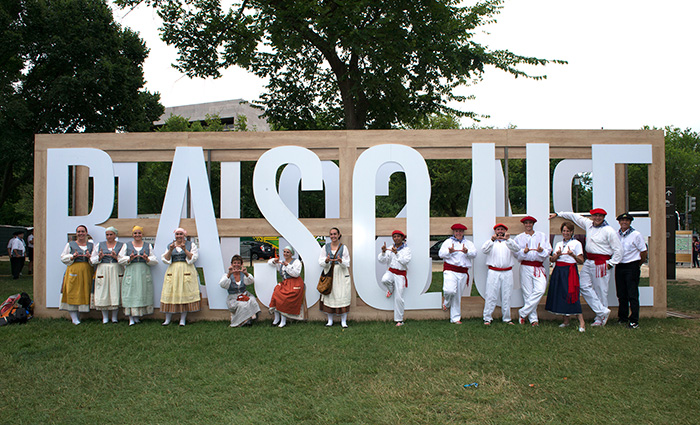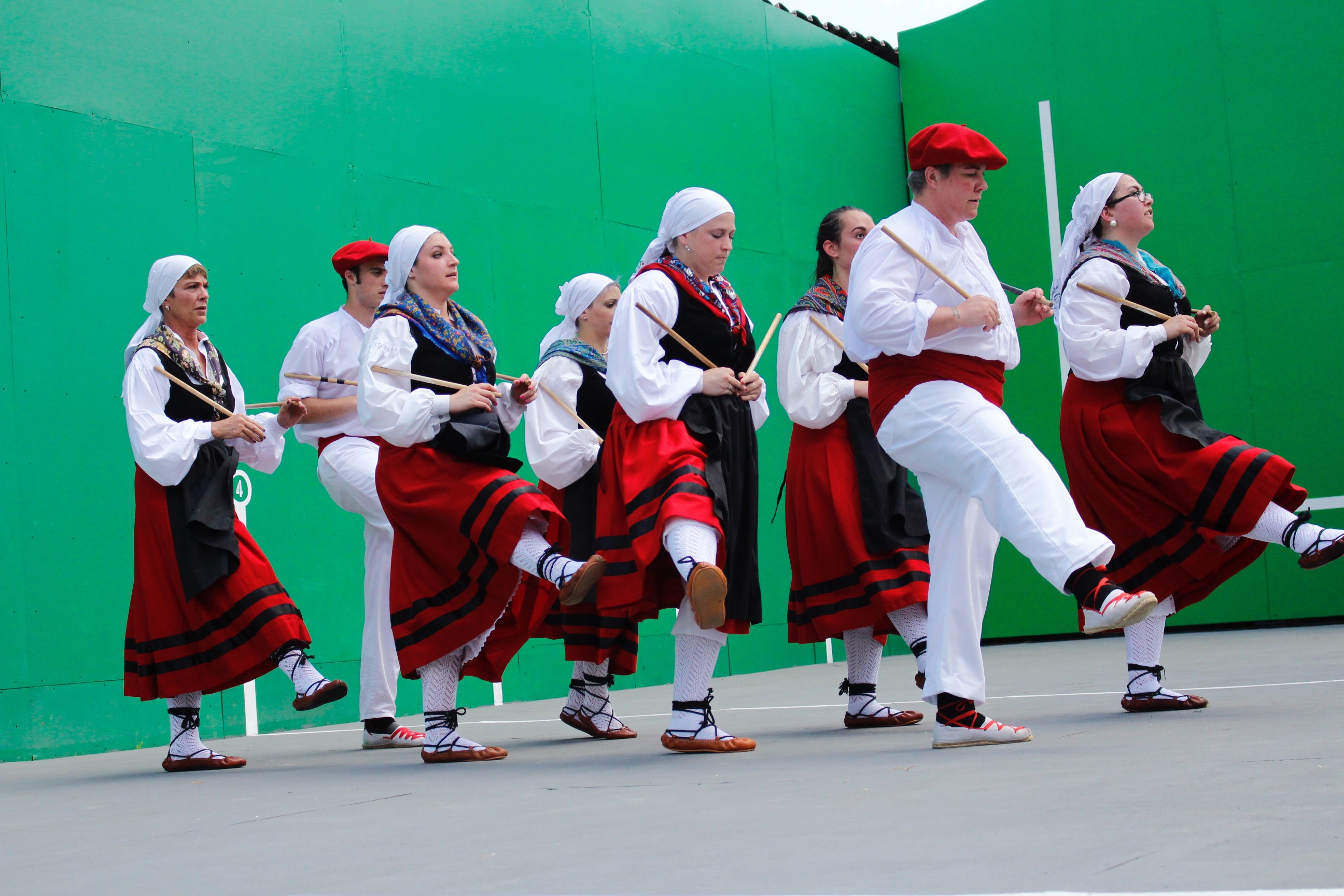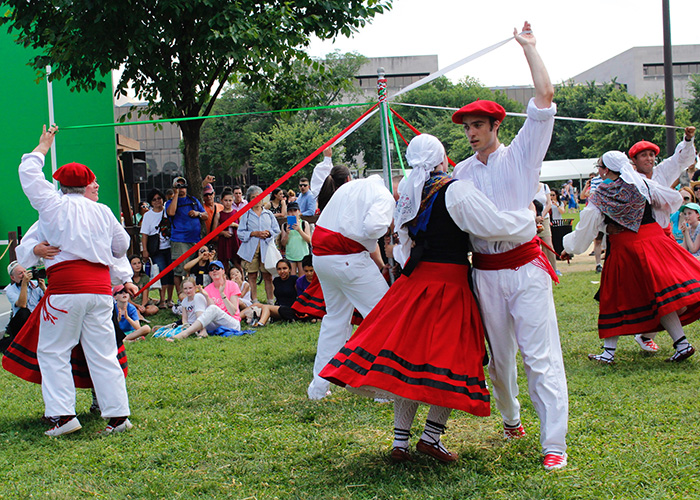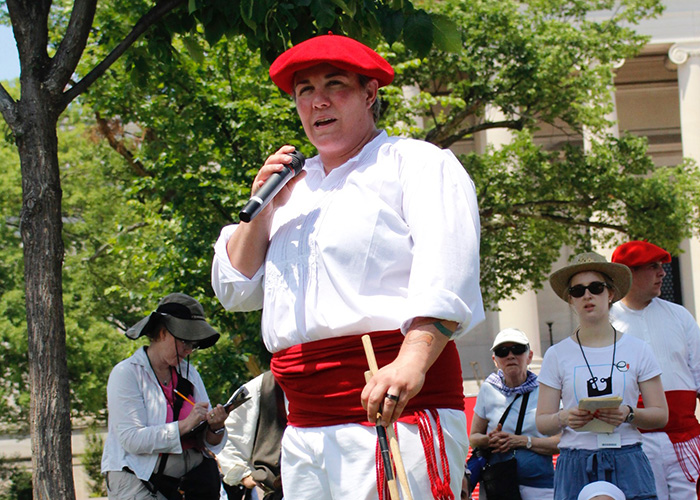Utah’Ko Triskalariak: A Family Dance Affair

Seven Basque American dance troupes performed at the 2016 Folklife Festival from across the American West, including Utah’ko Triskalariak. Founded by the Basque Club of Utah in Salt Lake City, this troupe educated, entertained, and provoked conversation about Basque American dance, heritage, and culture. Although only fifteen dancers came to Washington, the group normally consists of about twenty-five members, ranging in age from nine to fifty years old.
For the past fifteen years, the group has been led by Cirbie Lee Sangroniz. Cirbie began dancing at age two and joined Utah’Ko when she was seven. An outgoing, passionate, and enthusiastic person, she has dedicated a large part of her life to sustaining, teaching, and performing Basque dance. In this interview, she spoke about their dance styles, her experiences of Basque summer camp, the extended nature of Basque families, as well as performing on the National Mall.
What styles of dance do the Utah’Ko dance troupe perform?
The majority of Salt Lake, Boise, and Elko focus more on the Bizkaian dance styles. Then when you go into California, they focus more on the French province dances. Dance styles changes from province to province, as well as from town to town within Basque country.

For our dance group, we try to teach from all seven Basque provinces. I will spend hours watching YouTube videos of dances from over there. I know instructors and people from other provinces and they will send me videos, and I will write down steps, and then teach the dances. We use our online connections to other Basque instructors and also DVDs to reinforce the dances.
Your aunt was a member of the dance troupe. Who else from your family dances?
My sister, my mom, my aunt, my cousin, and his older brother dance with us. Then I have an aunt, an uncle, and two cousins in Boise who dance for their dance troupe.
That is a lot of family!
In a way, we all are family, but a lot of us aren’t related.

When we go to the Basque country or people come from the Basque country, we treat each other like family no matter what. That is one way I have made the connections that I have. We have had a lot of instructors come over from the Basque country to teach us dances, or they will come over to teach one of the other groups, and then do their thing with us.
One of the dance instructors came on Halloween, so we took them trick-or-treating. One of the girls had never been trick-or-treating before, didn’t have a clue what it was, so she got to go with these little kids in our Basque club. She thought it was the coolest thing. We had a big Halloween party for them, and we just hung out with them. We bought them University of Utah gear, and they still send us pictures when they wear it.
When I went over there, they did the same thing—open arms. They took me out to dinner, they bought me drinks. It’s a tight-knit community. It truly is a big family. We might be related—generations and generations and generations ago—but here we are definitely related. We are family.
Can you talk about the Udaleku Basque summer camp?
Udaleku is a two-week music camp that the kids get to come to. Back when I went, you just signed up and everyone went. Now it is a lottery pick because so many kids are going. This year Udaleku is in Salt Lake for the first time since 1984. We have eighty kids who will be at camp with us. We get to teach them music, dance, culture, language. They learn how to play cards.
Bernadette Leonis, who is working for the Smithsonian Festival, and I met twenty years ago this summer at our first music camp. Teresa Franzoia, the director for the Oinkari Boise Dancers, and myself—we grew up together. Again, no relation amongst the three of us, but we are family. They are my best friends.
The experiences of growing up in the Basque community are something that you cannot take away. Growing up in the Basque community means that you meet people from other dance groups and cultures, and they are just family—there is nothing else to it. You keep in contact. When we were kids, we would write letters—snail mail letters. And then when we got email, we sent emails to each other. And now it is texting!

How have you liked being at the 2016 Folklife Festival?
Minus the humidity, we have loved it! It is really cool how you guys have done a little bit of everything. When you go to the festivals in the West—Elko, Boise, Chino, Reno, San Francisco, Salt Lake, everywhere there is a Basque community—the festivals are all very similar. The dance groups perform, then sporting groups go, and then the bertsolaris go. It is all one after the other. So it is cool to see it in a different form, being able to walk around and expose our unique culture to the world, and let them know that we do exist.
Most people in America that don’t know what the Basque people are like: “What’s that!? Are you a fish? Are you a thing to eat?” “No… not a fish.” So it is really cool to be here. Especially to be at the nation’s capital, on the National Mall, it is truly an honor. To me this is the coolest thing.
SarahVictoria Rosemann is a media intern for the Center for Folklife and Cultural Heritage.

